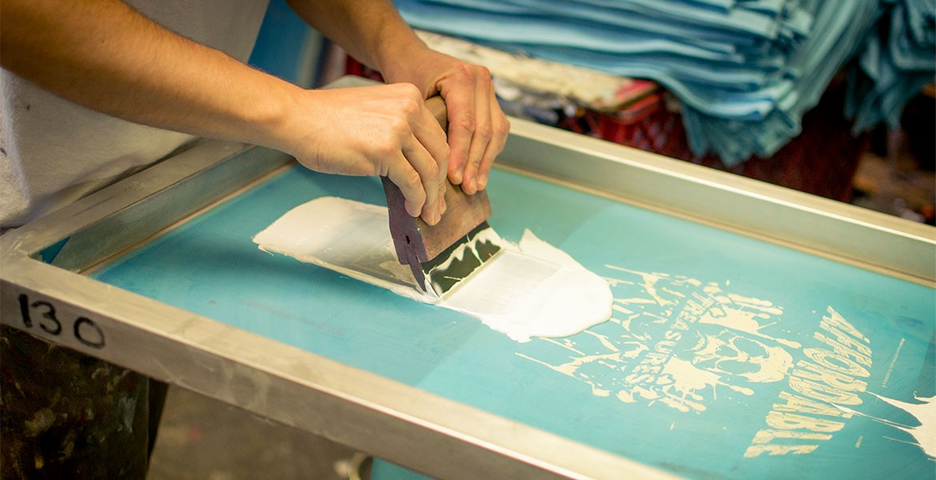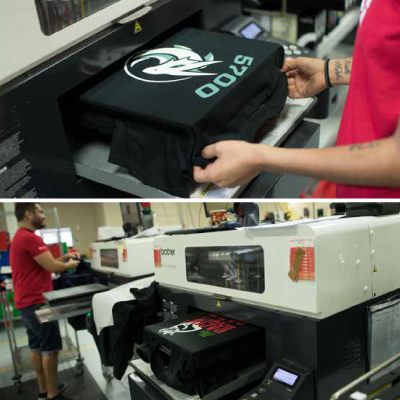Tx Tees for Beginners
Tx Tees for Beginners
Blog Article
The Of Tx Tees
Table of ContentsSome Known Questions About Tx Tees.What Does Tx Tees Mean?Little Known Questions About Tx Tees.The Best Strategy To Use For Tx TeesLittle Known Facts About Tx Tees.Not known Details About Tx Tees The Main Principles Of Tx Tees
That brings your total amount to around $1,900 before tax and delivery. Accumulate other prices, like the variety of utilities it requires to run the shop and the expense of ink and emulsion per design. screen printer. Take the print listed below. This is a one-color picture, so the cost of ink per t shirt is roughly 20 cents.The emulsion must just be a couple of cents considering that you 'd just require to layer one display for this task. Normally, printers attempt to make up to 45% earnings on a print job.

With DTF, you can publish a handful of t shirts, or simply one. Use the same calculator as the section above to calculate just how much revenue you 'd use DTF transfers. Compare the prices and earnings to whichever technique speaks best to your arrangement and procedure. Both screen printing and DTF have their particular niches worldwide.
See This Report on Tx Tees
The finest means to know? Ask around and see what printing shop like your own are doing. custom monograming. Try both out and see which you like better
When you're choosing what sort of printing method to utilize for printing your artwork layouts on your garments, it is very important that you understand the distinctions in between these 2 strategies so you can make the most of results while decreasing prices. Display printing is the most commonly used technique for printing designs on textiles.
DTG printing is also referred to as area or direct to garment printing since it prints only what is needed instead of making a screen as display printers do. https://businesslistingplus.com/profile/txtees02/. Screen printing functions by screen filler squeegee display printing ink screen mesh display, then moving the image to garment making use of heat and/or pressure
The DTG printer makes use of special dye-sublimation inks that are used into a pre-designed photo by a digital printing system. The inks enter into the textile, enabling vibrant colors and remarkable information. It's also recognized as spot or direct to garment printing due to the fact that it prints just what is required as opposed to making a display as screen printers do.
Rumored Buzz on Tx Tees
First, it's much faster - you can publish a fullcolor photo in minutes, as opposed to hours for screen printing. Second, there's no established time or expenses involved - you can print any layout you such as, without needing to create a display first. Third, there's no waste - because display printers display print one design each time, they have to evaluate each shade separately.
The paper is very costly and can only be made use of as soon as. Once it's published on, it has actually to be thrown out. - The initial acquisition price is lower than the ahead of time financial investment of DTG printers- You can publish multi-color designs one screen each time rather than having to print each shade individually like DTG printing.

Things about Tx Tees
Rather of making use of display mesh as screen printers do, color sublimation printers make use of laser technology to move your pictures onto garments or paper. A warm process moves the color from its solid-state straight right into the gas phase which in turn merges it onto fabric substrates when they are quickly warmed to high temperature levels under high pressure.
Sublimation printing is environment-friendly. It makes use of less water than screenprinting, and because it does not involve using dangerous solvents, it's safe for all types of apparel. The color sublimation inks are likewise unsmelling when treated, unlike screen printers that make use of hazardous chemicals throughout the screen printing procedure that leave an undesirable smell.
They additionally conserve cash on pricey tools like direct exposure devices since dye sublimation printers don't require a UV exposure unit or a flash cure oven that is generally utilized in screen printing (custom screen printing). What is straight to garment printing (DTG Printing)? DTG printing is an electronic screenprinting procedure that prints directly onto fabric using specialized inkjet printers
Not known Details About Tx Tees
DTG printing uses numerous advantages over standard screenprinting, including the ability to publish photographic quality photos, higher color vibrancy, and the capability to publish designs on darker textiles. DTG printers work by warming the textile ink till it becomes a gas. The gas after that permeates the material, bonding with the fibers to develop an irreversible print.

Screen printers simply prepare their screen then begin publishing till they lack item or ink.- There is a variety of knowledgeable display printers around the world, which can be valuable for novices. - It's a slower process - screen printers often need to await the ink to completely dry before they can print the following shade- Screen printers require hands-on labor, so there's a greater discovering curve and it takes longer to produce a top quality design- Display printing isn't as precise as DTG printing, so you may obtain some "blood loss" of colors from one part of the photo onto one more if not done effectively.
Facts About Tx Tees Uncovered
However, as opposed to using display mesh as screen printers do, color sublimation printers use laser modern technology to transfer your photos onto garments or paper. A warmth process moves the dye from its solid-state straight right into the gas phase which subsequently fuses it onto material substrates when they are quickly warmed to high temperatures under high stress.
Sublimation printing is environmentally friendly. It makes use of less water than screenprinting, and since it does not involve the usage of harmful solvents, it's risk-free for all kinds of apparel. The dye sublimation inks are additionally odorless when treated, unlike display printers that make use of damaging chemicals throughout the display printing process that leave behind an undesirable smell.
They also save money on pricey equipment like exposure systems given that color sublimation printers don't require a UV exposure system or a flash treatment stove that is typically utilized in screen printing. What is direct to garment printing (DTG Printing)? DTG printing is an electronic screenprinting process that prints directly onto material utilizing specialized inkjet printers.
The Ultimate Guide To Tx Tees
DTG printing uses lots of benefits over standard screenprinting, including the capability to print photographic quality photos, better shade vibrancy, and the capability to print designs on darker textiles. DTG printers function by heating up the textile ink until it transforms right into a gas. The gas then permeates the textile, bonding with the fibers to develop a long-term print.
Report this page